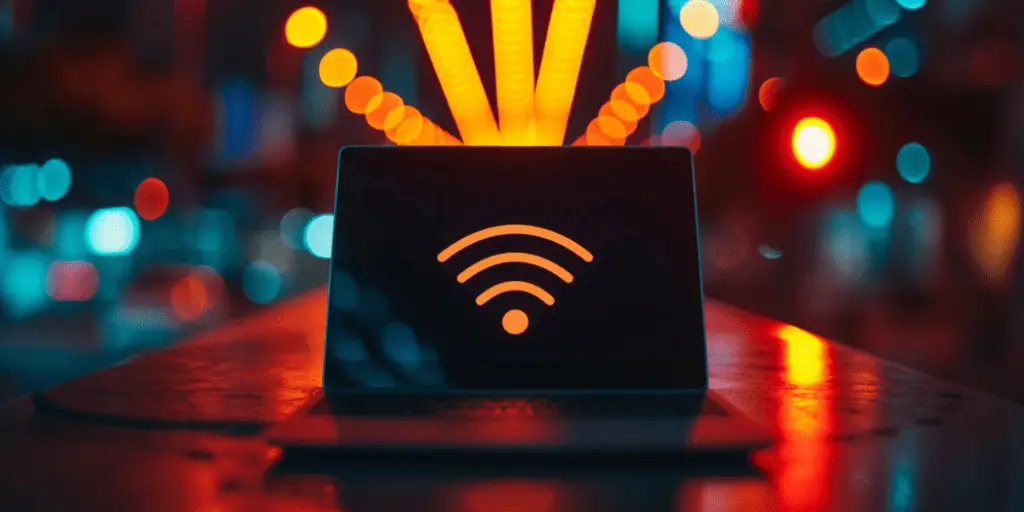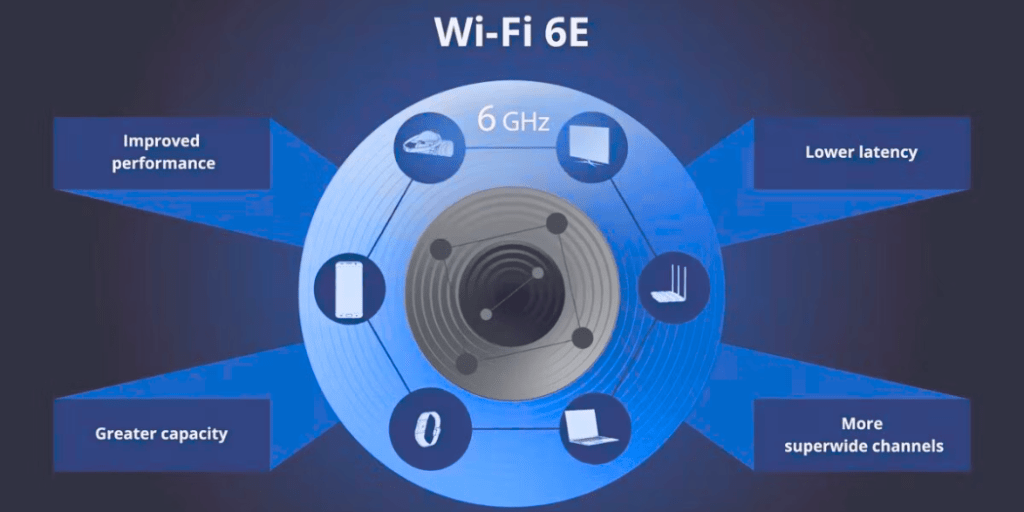Wi-Fi has consistently played a pivotal role in shaping how we connect and interact with the digital world. The introduction of Wireless Fidelity 6E marks a significant milestone in this ongoing evolution, offering a substantial leap forward in Wi-Fi capabilities.
Building on the foundation of Wi-Fi 6, which itself brought considerable improvements in speed, efficiency, and capacity, Wi-Fi 6E extends these enhancements into an entirely new spectrum—the 6 GHz band.
Wi-Fi 6E is not just an incremental update; it represents a transformative shift in wireless communications.
By accessing the clean and broad spectrum of 6 GHz, Wi-Fi 6E promises to alleviate network congestion, minimize interference, and provide much faster connection speeds.
This extension into the 6 GHz band means more bandwidth, wider channels, and the ability to handle more high-demand applications seamlessly, such as high-definition video streaming and virtual reality.
Wireless Fidelity 6E
Wi-Fi 6E represents a significant advancement in wireless technology, extending the capabilities of the existing Wi-Fi 6 standard into the newly available 6 GHz band.
This extension enhances the performance features of Wi-Fi 6. It opens up an additional spectrum for use, vastly improving the overall network efficiency and capacity.
Wi-Fi 6E enables devices to operate in the 6 GHz spectrum, which adds up to 1200 MHz of additional bandwidth in the US and other regions and nearly 500 MHz in the European Union.
This new spectrum is crucial as it allows for less congested airwaves, enabling cleaner and more stable connections. The 6 GHz band is exclusive to Wi-Fi 6E-enabled devices. It means older devices cannot cause interference within this band, ensuring optimal performance.
This technology improves overall efficiency by allowing multiple devices to share a single channel, reducing latency and increasing throughput.
Enhanced Wi-Fi security protocol that provides more robust protection against external threats.
Helps devices communicate more efficiently, reducing power consumption and improving battery life by scheduling communication times between the access point and the device.

When you can utilize the 6 GHz band, Wi-Fi 6E offers wider channels, which significantly boost data rates and reduce latency.
These wider channels are ideal for bandwidth-intensive applications such as augmented reality (AR), virtual reality, and high-definition video streaming.
The additional spectrum also means that Wi-Fi 6E can support a higher density of devices without sacrificing performance, which is crucial in crowded environments like stadiums, airports, and urban areas.
One of the most significant benefits of Wi-Fi 6E is the reduced interference from other devices.
As Wi-Fi 6E operates in a cleaner spectrum, devices are less likely to encounter interference from microwaves, Bluetooth devices, and other non-Wi-Fi sources that typically congest the 2.4 GHz and 5 GHz bands. This leads to more reliable and consistent connectivity.
Advantages of Wi-Fi 6E
The addition of the 6 GHz spectrum nearly triples the number of airwaves available for Wi-Fi. This massive increase in bandwidth means more available channels, which translates to less congestion and improved performance.
With more channels, Wi-Fi 6E can accommodate a higher volume of data transfer, supporting a denser population of devices without degradation in service quality.
Wi-Fi 6E supports channel widths up to 160 MHz, double the channel width available in Wi-Fi 6 on the 5 GHz band. These wider channels allow for higher throughput, essential for data-intensive applications.
Wider channels also enable faster connection speeds, making Wi-Fi 6E ideal for high bandwidth applications, such as streaming 4K/8K video, gaming, and virtual reality.
A significant advantage of Wi-Fi 6E is the reduced interference from other devices. The 6 GHz band is exclusive to Wi-Fi 6E-capable devices, which means no legacy Wi-Fi devices are operating in this band.
This clean spectrum reduces the likelihood of interference from other wireless technologies and older Wi-Fi networks, leading to more stable and reliable connections.
Wi-Fi 6E is particularly beneficial in high-density settings such as offices, stadiums, and educational institutions where many devices must connect simultaneously.
The additional spectrum and reduced interference help maintain high performance even in environments with competing connections. This capability makes Wi-Fi 6E a robust solution for enterprise and public networks that demand high capacity and reliability.
Wi-Fi 6E incorporates the latest security standards, including WPA3, which provides more robust encryption and greater security against cyber threats.
Technologies like OFDMA and TWT improve network communication efficiency, which helps reduce and save battery on client devices.
Wi-Fi 6E – Device Classes
They typically require coordination through an Automated Frequency Coordination service to prevent interference with incumbent services in the 6 GHz band.
The AFC system ensures these APs can operate without disrupting existing spectrum users. Standard Power APs are ideal for extensive coverage areas, including outdoor venues and large indoor spaces like convention centres and warehouses.
Low Power Indoor APs are restricted to indoor environments and operate at lower power levels than Standard Power APs.
These devices do not require AFC because their lower power limits potential interference with incumbent services.
LPI APs are designed to provide robust coverage comparable to existing 5 GHz Wi-Fi networks but with the added benefits of the 6 GHz spectrum, making them suitable for residential and corporate offices with high-density Wi-Fi coverage.

Very Low Power devices are the most restricted in terms of power usage. They are designed for portable or personal use, both indoors and outdoors.
VLP devices include smartphones, tablets, and other handheld devices that benefit from the increased bandwidth and reduced interference in the 6 GHz band. These devices are handy in scenarios where mobility and battery efficiency are paramount.
The availability and use of these device classes can vary significantly by region due to different regulatory requirements and spectrum allocations.
In the United States and parts of Asia, all three classes are widely supported, while in Europe, regulatory focus has initially been on Low Power Indoor devices to minimize potential interference issues.
Global Regulatory Status
The Federal Communications Commission has pioneered allocating the 6 GHz band for unlicensed Wi-Fi use in the United States.
The FCC has opened up a complete 1200 MHz of spectrum from 5925 MHz to 7125 MHz. This expansive allocation allows for indoor and outdoor usage of Standard Power, Low Power Indoor, and Very Low Power devices, subject to specific power and location restrictions to protect incumbent services.
European countries, coordinated by the European Conference of Postal and Telecommunications Administrations, have adopted a more cautious approach.
Europe has opened 480 MHz of spectrum in the lower part of the 6 GHz band primarily for Low Power Indoor use.
This limitation reflects concerns about potential interference with existing satellite and fixed services operating in adjacent bands. Discussions are ongoing to open additional spectrum up to 7125 MHz to harmonize with broader global standards.
Countries like South Korea and Japan have also embraced Wi-Fi 6E, with South Korea being among the first to allow the 6 GHz band for Wi-Fi.
The region generally follows a framework similar to the United States, allowing various device types to operate across the spectrum. However, specific regulations can vary by country.
Nations like Saudi Arabia, Brazil, Chile, and Guatemala have opened up the 6 GHz band for Wi-Fi 6E, each with specific national regulations that dictate the types of devices and power levels permitted.
These regions recognize the benefits of increased bandwidth and have swiftly adopted regulations that facilitate Wi-Fi 6E deployment.
Within Europe, the UK and Denmark have unique positions. The UK, for example, allows slightly higher transmit power and has a somewhat broader allocation. At the same time, Denmark aligns closely with the broader European CEPT decisions.
Wi-Fi 6E in Action
The deployment of Wi-Fi 6E across different industries showcases its ability to effectively support bandwidth-intensive applications and cater to high-density user environments.
In the corporate world, Wi-Fi 6E enables businesses to support many devices and applications without experiencing the bandwidth crunch typical of older Wi-Fi generations.
For example, enterprise environments like large offices and conference centres benefit significantly from Wi-Fi 6E’s enhanced capacity and efficiency, facilitating seamless video conferencing, large file transfers, and simultaneous connectivity for hundreds of devices.
Schools and universities leverage Wi-Fi 6E to provide robust wireless connectivity across campuses.
The technology supports a high density of users and many devices, making digital learning tools and online resources more accessible. Wi-Fi 6E ensures that students and faculty can maintain constant, uninterrupted access, crucial for educational continuity in today’s digital age.
Wi-Fi 6E is a game-changer in healthcare settings, where reliability and low latency are paramount. The technology supports telemedicine services, which rely on high-definition video calls and real-time data exchange.
Wi-Fi 6E helps deploy IoT devices for monitoring patient health metrics, thereby enhancing the overall efficiency of healthcare delivery.

For public venues like stadiums and transportation hubs, Wi-Fi 6E provides the necessary infrastructure to handle thousands of connections simultaneously, from ticketing and ordering systems to security and operations communications.
In smart cities, Wi-Fi 6E supports a wide range of services and applications, from traffic management systems to public safety networks, ensuring that these services operate smoothly without interference.
Wi-Fi 6E enhances the consumer experience at home by supporting more devices and offering faster speeds.
This is particularly beneficial in households with multiple streaming services, smart home devices, and remote workers or learners needing reliable, high-speed internet connectivity.
Future of Wi-Fi
One of the primary challenges for Wi-Fi 6E is navigating the complex and varied regulatory landscape across different regions. Different countries have different rules regarding using the 6 GHz band, which can complicate the rollout of universal Wi-Fi 6E solutions and affect interoperability.
Wi-Fi 6E operates exclusively in the 6 GHz band, so only devices equipped with Wi-Fi 6E capabilities can utilize this spectrum.
This necessitates users to upgrade their devices to benefit from Wi-Fi 6E, which may slow adoption among consumers reluctant to replace recent but incompatible hardware.
Infrastructure Investment infrastructure to replace existing Wi-Fi systems. This includes purchasing new routers and access points and upgrading network backbones to handle increased data throughput.
Despite the cleaner spectrum in the 6 GHz band, the requirement for automated frequency coordination to prevent interference with incumbent services, especially in outdoor settings, presents a technical and logistical challenge.
As technology evolves, the efficiency and capabilities of Wi-Fi 6E are expected to improve. Innovations in antenna design, power management, and frequency utilization could further enhance the performance and reliability of Wi-Fi 6E networks.
Analysts expect rapid growth in Wi-Fi 6E-enabled devices over the next few years, driven by consumer demand for better and faster Wi-Fi and manufacturers’ push to leverage the new spectrum. This growth will likely lead to more competitive prices and quicker adoption.
Wi-Fi 6E has the potential to become integral to the development of emerging technologies like augmented reality, virtual reality, and the Internet of Things. Its ability to support high bandwidth and low latency can significantly enhance the performance of these technologies.
Efforts to harmonize the use of the 6 GHz band globally will continue, potentially leading to a more standardized approach to spectrum management. This could simplify the deployment of Wi-Fi 6E technology and maximize its global impact.
Final Thoughts
Wi-Fi 6E represents a significant leap forward in the capabilities of wireless technology, bringing unprecedented improvements in speed, capacity, and efficiency.
By unlocking the potential of the 6 GHz band, Wi-Fi 6E offers a cleaner, broader spectrum that allows for more devices to connect without the interference that plagues earlier Wi-Fi generations.
This advancement enhances user experience and opens the door to innovative applications in industries as diverse as healthcare, education, and public infrastructure.
Despite the challenges related to regulatory variations, device compatibility, and the need for new infrastructure investments, the future of Wi-Fi 6E is bright.
As more devices become Wi-Fi 6E capable and global spectrum regulations harmonize, adoption is expected to accelerate, bringing the benefits of this advanced technology to a broader audience.


